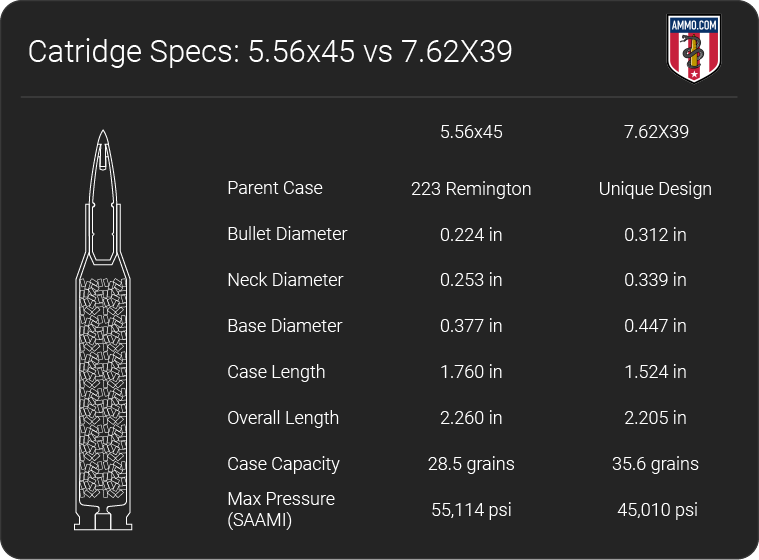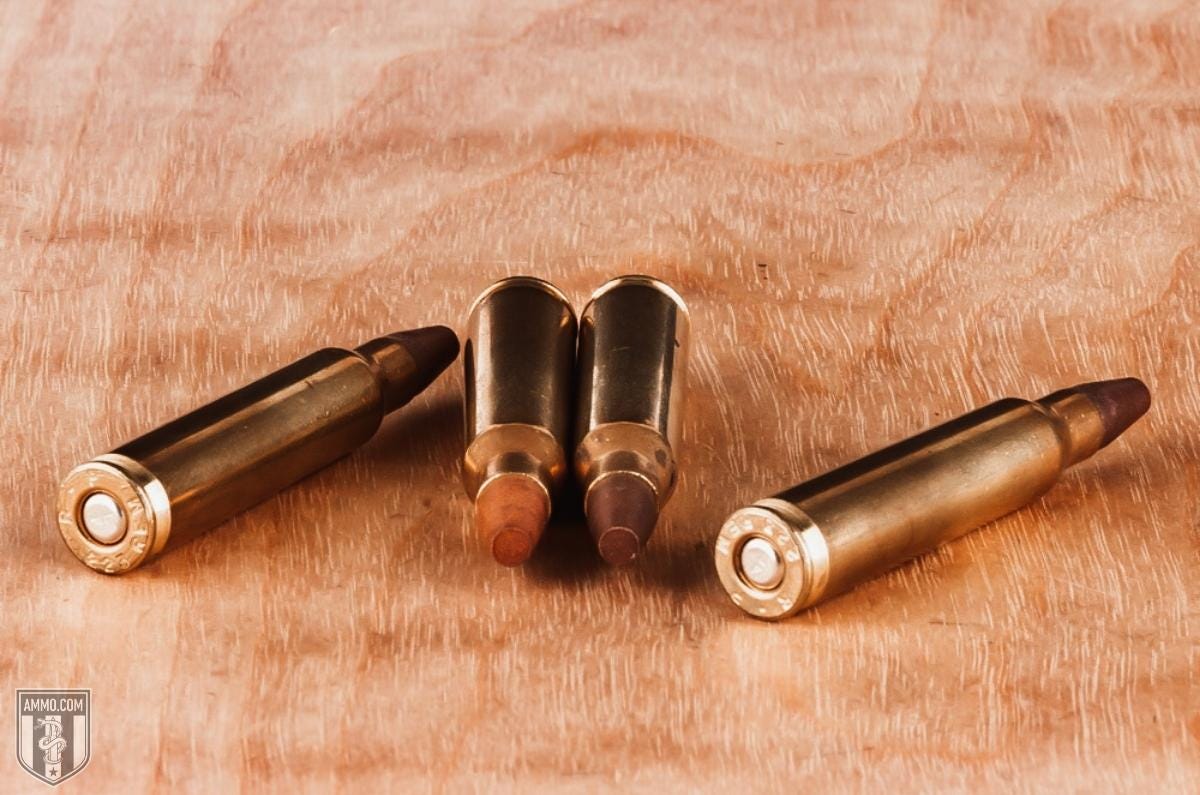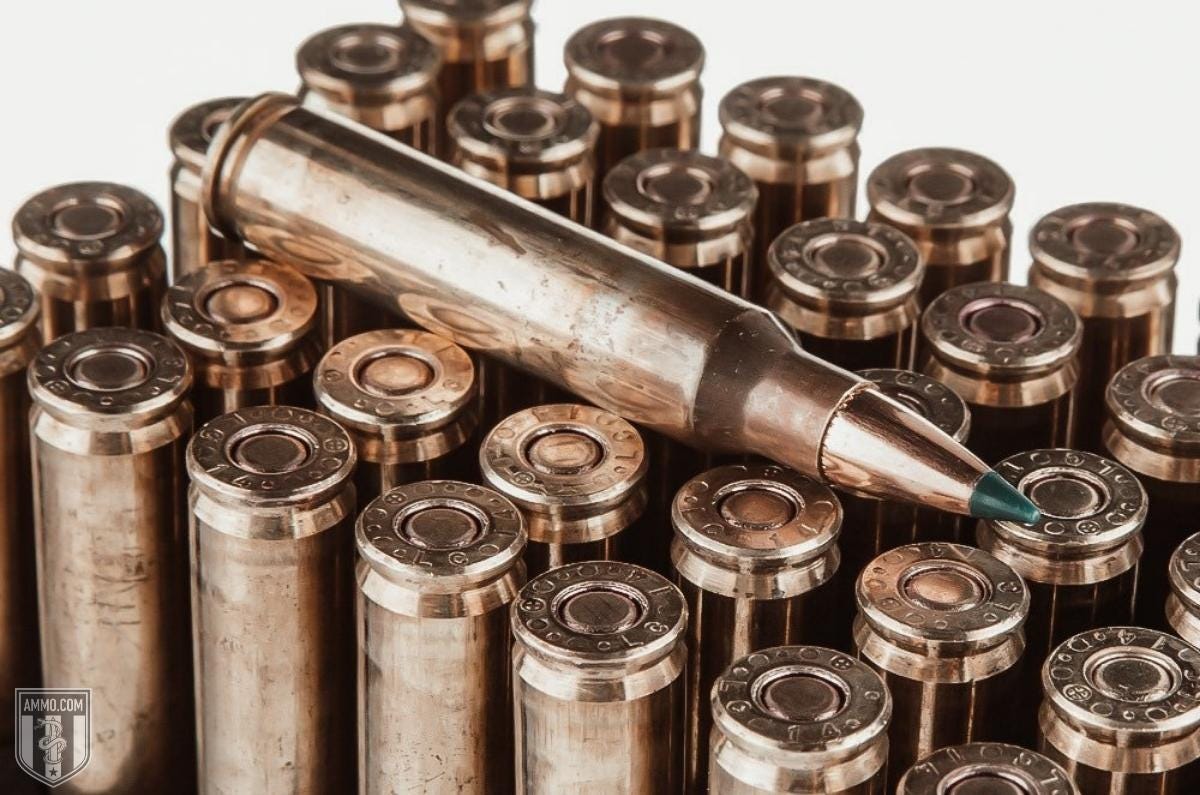 5.56 vs 7.62x39
5.56 vs 7.62x39
IPFS
5.56 vs 7.62x39: The Battle Rifle Blitz
Written by Sam Jacobs Subject: Gun RightsWhen it comes to selecting a semi-automatic rifle cartridge, the 5.56x45mm NATO and the 7.62x39mm are always front and center in the conversation.
Both rifle rounds have been forged in the fires of battle from Vietnam, Iraq, and Afghanistan as well as a host of other conflicts across the globe. As a result, they are two of the most popular rifle cartridges on the planet.
Virtually every military on Earth uses one of these two rifle rounds for their primary battle rifle. And there's a good reason for that! Their terminal ballistics and effectiveness in close quarters battle (CQB) are second to none.
But which rifle cartridge is better suited for you and does it matter?
Let's take a closer look at the caliber debate that defined world conflict since the Cold War, the 5.56x45mm NATO vs 7.62x39mm.
A Note on Nomenclature: 223 Remington vs 5.56 NATO
Please note that within this article we will refer to the 223 Remington (223 Rem) and the 5.56x45mm NATO round interchangeably.
There are differences between the two and you can read about them HERE.
In short, a 223 Rem can safely be fired from a rifle or handgun chambered in 5.56, however, the opposite is not true.
5.56 vs 7.62x39: Let the Caliber Cold War Begin
Ever since the Vietnam War when the 5.56 and 7.62x39mm first squared off toe-to-toe, many militaries around the world have adopted one of these rifle cartridges as the chambering for their primary battle rifle. This has led many internet gun forums to delve into intense heated debates over the combat effectiveness and lethality of each round to determine which one is "best". Most of these caliber debates come down to terminal ballistics, effective range, stopping power (ft-lbs), muzzle velocity (FPS), accuracy, and bullet weight.
In one camp, we have the 7.62x39 comrades with their AK-47 assault rifles, AKM variants, SKS rifles, and RPK machine guns. They tout the 7.62x39 as firing a heavier bullet that hits with the kinetic energy equivalent to Thor's Hammer, superior barrier penetration, and enough stopping power to put a Siberian brown bear into permanent hibernation.
And in the other camp are the marksman of the 5.56 NATO cartridge with their beloved AR platform, M4 carbine, or bolt action varmint rifles. These shooters proclaim that "speed kills" and a lighter-weight bullet traveling at high muzzle velocity and higher pressure are preferred as they cause massive amounts of damage via hydrostatic shock. With a flatter trajectory and less recoil, the 5.56 shooters proudly boast of their sniper rifle accuracy over longer ranges than the slow and chunky 7.62x39 crowd could only dream of.
I hope you enjoyed some sarcasm there, but sadly this is what the caliber debate has come to in some forums.
The truth is that both rifle rounds are extremely effective in close-quarters battle and engagements at longer ranges, and this has been proven many times over in Iraq and Afghanistan. No matter which semi-automatic rifle cartridge you choose, it will not fail to deliver in any self-defense situation.
However, which ammo will be best for you is a deeper question that warrants a broader comparison of the 5.56 NATO round and the 7.62x39. Let's begin by analyzing the Cartridge Specs for each.
Cartridge Specs
When evaluating two rifle rounds, it's a good practice to look at the cartridge specs to see how they compare. And although the 5.56 and 7.62x39 couldn't be more different from one another, there are some nuances that we can evaluate from the spec chart.
The first major difference is the bullet diameter each cartridge fires. The 5.56 fires a 0.224" diameter while the 7.62 fires a 0.312" diameter bullet.
This is one flaw in the Russian nomenclature that confuses some new shooters, as the 7.62x39 does not fire a 7.62mm (0.308") diameter bullet like the 7.62x51 NATO (308 Winchester). Instead, it fires a 0.312" diameter bullet like the 303 British cartridge.
This lets us know that the 7.62x39 will likely be firing a heavier bullet at a lower muzzle velocity while the 5.56 will be firing a smaller bullet at a higher muzzle velocity (FPS).
The wider base diameter of the 7.62 allows for more case capacity than the 5.56, which is needed to push those heavier caliber bullets at an acceptable velocity to be effective at longer ranges. On the other hand, the 5.56 has a longer overall length as it is a thinner, longer case while the 7.62 is shorter and wider.
The last major difference is the maximum pressure. The 5.56 creates higher pressure in the chamber to reach those higher velocities needed to be combat effective, whereas the 7.62x39 can get by with lower pressures.
One note on the maximum pressures listed, the 5.56 NATO round is not registered with SAAMI, so the pressure limits listed are based on CIP data.
Now that we have a clearer understanding of the cartridge specs, let's talk about recoil.
Recoil
Although both rifle rounds are becoming more popular in the hunting community, they are first and foremost frontline ammunition for combat troops. As such, having a round that has less recoil is preferred as it allows for faster follow-up shots during semi-automatic fire.
Both the 5.56 and 7.62 have very low recoil when compared to larger rounds like the 308 Winchester, 30-06 Springfield, and 7.62x54R.
Felt recoil is primarily a function of bullet weight, case capacity, and rifle weight. Therefore, a heavier bullet with a larger powder charge will recoil more than a lighter bullet with a lower powder charge.
A 7.62x39 will typically fire a 123 grain bullet while the 5.56 NATO cartridge will typically fire a 55 or 62 grain bullet (although heavier bullets can also be used).
Assuming a 7-pound rifle, the 7.62 will have approximately 8.5 ft-lbs of felt recoil compared to 5 ft-lbs of felt recoil for the 5.56 NATO round. And this is not overly surprising as the 5.56 is firing a considerably lighter bullet (albeit at higher muzzle velocity) than the 7.62x39.
Now it's true that the 5.56 has less recoil, and this is preferred, but the recoil from the 7.62 is not oppressive by any stretch of the imagination. Shooters should not experience much of a recoil flinch from either round as they are both very pleasant to shoot.
Recoil is further mitigated in the AR platform due to the use of the buffer tube and recoil buffer to soften the reciprocation of the bolt carrier group (BCG) during firing. Many shooters who utilized the AR-15 describe it as having virtually zero recoil, which makes it a dream to shoot.
One major difference when it comes to recoil is the difference between semi-auto vs full-auto fire (AKA the happy switch). In the case of fully automatic fire, there is a noticeable difference between the two rifle rounds. The heavier recoil of the 7.62 will be more difficult to control during full auto when compared to the 5.56.
I know because I've shot both!
Now, for mounted machine guns or those using a bipod, such as the RPK or the M249 SAW, there will be little difference in full auto as the mount or bipod will help mitigate muzzle rise.
However, when it comes to muzzle rise while using an assault rifle, the M4 carbine and 5.56 NATO cartridge are easier to control.
The short-stroke gas piston, lack of a recoil buffer, and overall heavier recoiling round for the AK-47 lends itself to more muzzle rise during automatic fire. Although it's not impossible to control the 7.62x39 in full auto, it takes more practice, training, and strength to keep the muzzle down compared to the M4 carbine and 5.56.
Trajectory
Trajectory is how we quantify a bullet's flight path to its target measured in inches of bullet drop. A flatter trajectory is preferred as it requires less sight adjustment and provides a longer effective range.
Muzzle velocity can affect trajectory as well since a bullet that is moving at high velocity arrive at its target quicker and provide gravity less time to affect its flight path. And when it comes to muzzle velocity and trajectory, the 223 Rem leaves the 7.62x39 eating its dust.
Looking at the ballistics tables below, you can see how much flatter shooting the 5.56 is compared to the 7.62.
At 400 yards, you can see that the 62-grain bullet of the 5.56 NATO round has dropped about 23" while the 7.62x39 has plummeted over 44". That's virtually a 2-fold difference between the two rounds.
The 5.56 NATO cartridge was designed to be effective at long-range and short-range engagements, and the lightweight, super high-velocity 55gr and 62gr bullets used by the U.S. military are extremely effective at this.
Although the 7.62x39 can still be effective at range, it requires considerably more sight adjustment to account for the massive bullet drop the round experiences outside of 300 yards.
In terms of trajectory, the 5.56 NATO cartridge is undoubtedly the flatter shooting round.
Accuracy
The 7.62x39 has gotten somewhat of a bad rap as being an inaccurate round. Some of this is likely due to inconsistencies in the ammo itself and the rest is inherent to the AK platform specifically.
Former Communist Bloc manufacturing processes were not exactly ISO 9001 Certified if you catch my drift. Therefore, sometimes inconsistencies in powder charge or bullet seating depth of 7.62x39 ammo have been observed, and these differences between rounds will affect the point of impact. Reliability is always important in a battle rifle and the AK platform is known for its undying reliability. However, to achieve this the AK was designed with looser tolerances (especially in the chamber), and this often leads to decreased accuracy. Furthermore, the majority of 7.62 cartridges are steel cased, which does not allow the case to form to the chamber during firing.
To learn more about Steel Cased Ammo Click HERE.
But what about newly manufactured 7.62 ammo?
Newly produced 7.62x39 ammunition is considerably more consistent than its surplus predecessor from the spam can. However, most of your cheap steel-cased ammo is not going to be match grade, even the more expensive 7.62x39 will not compare with the consistency of 5.56 ammo. With optimized handloads for 7.62x39, I suspect that MOA level accuracy could be obtainable for a solid marksman. However, most off-the-shelf 5.56 cartridges will be more consistent and accurate than 7.62x39.
Ballistic Coefficient
Ballistic Coefficient (BC) is a numerical representation of how well a bullet resists wind and air resistance. It's a measure of how aerodynamic a bullet is, a high BC is preferred and means the bullet will buck the wind easier. The way a BC is calculated is rather complicated and irrelevant for this article, however, heavier bullets will typically have a higher ballistic coefficient.You would then logically theorize that the 7.62x39 would dominate in terms of BC as it fires a heavier bullet…but this isn't the case.
Bullet design also plays a role in the BC calculation, and the shorter/chunkier 0.312" diameter bullets used for 7.62 are not the most aerodynamic. As such, the 5.56 slightly edges out the 7.62 in terms of Ballistic Coefficient. On average, 5.56 will have a BC of 0.29 while the 7.62 sits at 0.27. It's not a huge difference, but the 5.56 will be slightly more resistant to wind drift.
Sectional Density
Sectional Density (SD) is the measure of how well a bullet penetrates a target. This is extremely important when hunting big game, as you need a bullet that can punch through thick hide, bone, and sinew. Sectional density is calculated by comparing the bullet weight and the bullet diameter, the greater the number the more effective it will be at penetrating a target.
The greater the SD the deeper the bullet will penetrate the target. Although the 7.62x39 uses a heavier bullet weight, this does not correlate with an increase in SD as it is traveling at a slower FPS. In contrast, the 5.56 is moving at a higher FPS and concentrates all its force into a small area.
As such, the Sectional Density comparisons between 5.56 vs 7.62 are virtually identical.
Hunting
Although both rifle rounds were made for battle, they have both become popular as a hunting round as well. The 223 Remington/5.56 NATO has always been considered a varmint round and is extremely effective on small game like groundhogs, prairie dogs, coyotes, and foxes.
Although the 5.56 is an extremely effective round on two-legged varmints, it is typically not considered a proper round for whitetail. Many states and provinces in North America have a minimum bullet diameter allowed for deer hunting, and typically that bullet diameter is a minimum of 0.243" or higher.
This keeps the 5.56 relegated to small game and varmint hunting only.
However, the 7.62x39 can step in as a hunting round that is appropriate for deer, feral hogs, and other medium-sized game. The 1500 ft-lbs of muzzle energy generated by the heavier 123-grain 7.62 bullet is more than enough to fall a deer out to around 150 yards. Hollow point and soft point ammo are currently available in 7.62x39 and provide appropriate terminal ballistics to humanely claim game.
However, many regions have regulations concerning hunting with semi-automatic rifles. Furthermore, the accuracy issues with some AK variants might also make it a less than ideal choice when picking a rifle to take into the woods.
That is, of course, unless you want to pretend you are hunting the Viet-Hogs in the brush of the Mekong Delta…if that's the case then strap up your SKS and go harvest that boar!
However, if you want to milk all the performance possible out of the 7.62 round, a bolt action rifle would be the best choice. In this case, the Ruger American Hunter or the CZ 527 are your primary rifle options.
To summarize, the 5.56 makes an excellent hunting round for varmints and small game with its lightweight bullets, long-range capability, and flatter trajectory. The 7.62x39 is an excellent choice for deer and medium-sized game under 150 yards provided you are using a proper hollow point or soft point bullet for added expansion.
Self Defense/Home Defense
When it comes to self-defense, there's no denying that both rifle rounds will get the job done. This has been proven on the battlefield for well over 60 years and counting. The 7.62x39 is renowned for its stopping power as it delivers a punishing amount of kinetic energy into its target. In a short-range or CQB context, it's hard to debate the terminal ballistics offered by the 7.62 are nothing short of spectacular.
Therefore many ranchers and farmers will carry a 7.62 rifle like the Ruger Mini-30 or SKS in their truck to dispatch predators or defend their property.
In contrast, the 5.56 offers lower recoil, higher muzzle velocity, and a flatter trajectory at the cost of less muzzle energy. However, as most self-defense conflicts occur under 100 yards, this gives the advantage to the 7.62x39.
But let's be honest about one thing, it's unlikely that most of us will be packing our semi-automatic rifle in a self-defense situation unless you live in the country. Since the vast majority of CCW permit holders will be carrying a handgun when they are out in public, the question of home defense becomes a more pertinent question to answer for the 5.56 vs 7.62 debate.
And one of the most important factors to discuss when talking about home defense is overpenetration. The absolute last thing any shooter wants is for their round to penetrate through the bad guy and into an innocent bystander.
The 7.62x39 gained quite a reputation in Vietnam for its ability to penetrate barriers and brush. For this reason, the 7.62 is not well suited for home defense. Modern home/apartment construction is notoriously flimsy and a 7.62x39 will have no issues blasting through sheetrock, vinyl siding, and into your neighbor's unit or kitchen.
Although the 5.56 offers a little less kinetic energy, it was developed to cavitate, tumble, and fragment when it entered soft tissue. This causes additional damage to the target and limits overpenetration.
Don't get me wrong, the 5.56 can easily penetrate through drywall and siding like the 7.62, however, the lighter weight bullets fired by the 5.56 are easier to deflect and should over-penetrate less than the 7.62x39.
Continue reading about the difference between 5.56 vs 7.62x39 here.















